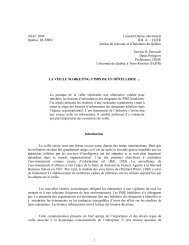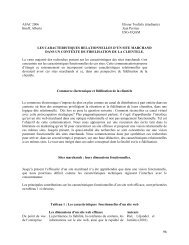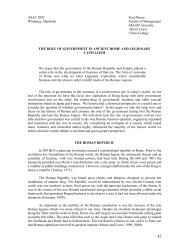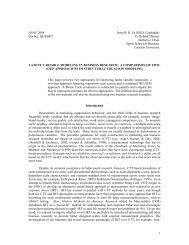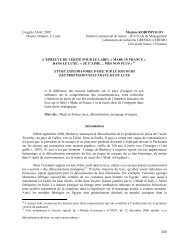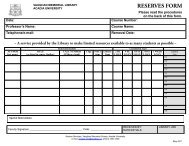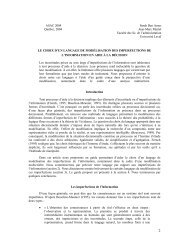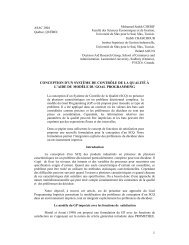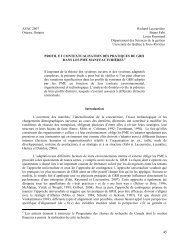ASAC 2004 – Quebec City Lynne Gillis – St. Francis Xavier ...
ASAC 2004 – Quebec City Lynne Gillis – St. Francis Xavier ...
ASAC 2004 – Quebec City Lynne Gillis – St. Francis Xavier ...
Create successful ePaper yourself
Turn your PDF publications into a flip-book with our unique Google optimized e-Paper software.
<strong>ASAC</strong> <strong>2004</strong> <strong>–</strong> <strong>Quebec</strong> <strong>City</strong><br />
<strong>Lynne</strong> <strong>Gillis</strong> <strong>–</strong> <strong>St</strong>. <strong>Francis</strong> <strong>Xavier</strong> University<br />
Barry Wright <strong>–</strong> Brock University<br />
THE PROMOTION OF PRESECRIPTION DRUGS: INFLUENCING PHYSICIAN’S<br />
CHOICE BEHAVIOUR<br />
Growing interest has been directed to the role pharmaceutical sales<br />
representatives play in influencing physician’s choice behavior. To examine this<br />
relationship, in-depth interviews were conducted with 11 physicians from Nova<br />
Scotia to understand how they perceived the working relationship between<br />
themselves and pharmaceutical sales representatives. Three themes emerged<br />
consistently suggesting an appreciation/tolerance relationship, the use of several<br />
weapons of influence, and physician Irks and Asks. We conclude by identifying<br />
policy implications, as well as an agenda for research.<br />
The pharmaceutical trade is a booming business. Global pharmaceutical sales have been on the<br />
rise with sales growing 12% in 2001 to over $360 billion, with North American sales making up<br />
almost half of this (Mullin, 2002; Kelley, 2002). Roughly 4,000 new pharmaceutical drugs are in<br />
development, each attempting to come to market in Canada, all hoping to improve patient quality<br />
of life (Rao, 2000). As these new drugs come to the market, competition increases and<br />
pharmaceutical companies must work harder to preserve market share.<br />
The purpose of this paper is to examine the role that pharmaceutical sales representatives (PSRs)<br />
play in influencing physician’s choice behavior. It is important to examine this relationship<br />
because pharmaceutical industry marketing tactics have greatly changed over the last decade.<br />
They have become much more aggressive and intense (<strong>St</strong>rout, 2001; Raton & Ross, 2002) with<br />
pharmaceutical companies now devoting more money to the promotion and marketing of their<br />
drugs (Wilkes, Bell & Kravitz, 2000).<br />
While this method of marketing is widely used in the pharmaceutical industry, an extended search<br />
of various business literature and journals indicates a dearth of research in this particular area.<br />
Exceptions include, Andaleeb and Tallman (1996) who surveyed Pennsylvania physicians (n =<br />
95) about their relationship with PSRs. They found physicians reported friendly relationships<br />
with representatives but felt they could get needed information from other sources. They also<br />
found that the selling approach used by PSRs was not seen by physicians as being manipulative.<br />
Further, Gonul, Carter, Petrova, and Srinivasan (2001) completed a recent research study on<br />
PSRs in the United <strong>St</strong>ates and claimed to be the first attempt at an exploratory study of the effects<br />
of personal selling to physicians. Using a panel of physicians (n = 157), the authors investigated<br />
how pricing and promotional activities influenced prescription choice behavior. They found<br />
physicians have limited price sensitivity concerning their prescribing behaviours, that PSR<br />
detailing and samples have mostly an informative effect on physicians, and physicians with a<br />
relatively large number of Medicare patients were less influenced by promotions than other<br />
physicians.<br />
However, as Canada has different economic structures, medical/healthcare services, political<br />
structures and social attitudes (Feather, 1998; Course, 1995; Bodkin & El-Helou, 2001) these<br />
findings may not be generalizable to Canadian physician and PSR relationships. Unlike other<br />
countries, Canadian pharmaceutical companies are limited in their approach to promotion. For<br />
example, pharmaceutical companies are not permitted to advertise their drugs’ names or how they<br />
relate to certain ailments and diseases on television, radio or magazines and newspapers. As a<br />
result, the key marketing effort in Canada is around relationship selling with sales representative
‘educating’ physicians about their company’s drugs. Accordingly, Canadian pharmaceutical<br />
companies devote a significantly large portion of their marketing budget to ‘wooing’ doctors<br />
through various means with companies spending an estimated one billion dollars or $20,000 CDN<br />
used per Canadian physician (Foss, 2001).<br />
Theoretical Framework<br />
METODOLOGY<br />
This study used a qualitative methodology based on grounded theory (Glasser & <strong>St</strong>rauss, 1967).<br />
All interviews followed the “long interview” format outlined by McCracken (1988).<br />
Biographical questions were asked first, followed by a series of ‘grand tour’ questions and<br />
‘planned prompts’ (McCracken, 1988). Grand tour questions allow for the interviewee to tell their<br />
own story in their own terms. In order to gather further information, planned prompts are used to<br />
gain further reflection from respondents. The final step involved analysis of the data collected.<br />
The purpose here is to determine the “categories, relationships, and assumptions that informs the<br />
respondent’s view of the world in general and the topic in particular” (McCracken, 1988; pg. 42).<br />
Once these themes are developed, interrelationships as well as contradictions are looked for.<br />
Respondents<br />
For this study, a ‘purposeful sample’ (Lincoln & Guba, 1985) of general practitioner physicians<br />
with different profiles (e.g. size of community; length of service) were sought out. McCracken<br />
(1988) suggests 8 respondents are needed for an adequate respondent pool; for this research 11<br />
physicians were interviewed. As recommended by McCracken (1988), no respondent had prior<br />
contact/relationship to the researchers. To find the physicians for the research the annual listing<br />
2001/2002 of the Collage of Physicians and Surgeons of Nova Scotia was used. Sixty-five<br />
requests for interviews were faxed out to general practitioners across Nova Scotia with 11<br />
agreeing to be interviewed (17% responds rate). Ten of the physicians were male. 1 Respondent’s<br />
ages ranged from mid-thirties to late fifties, and length of time in practice spanned from 10 to 33<br />
years. Interviews lasted between 15 and 40 minutes, with the average interview lasting 25<br />
minutes (the 15 minute interview was cut short due to a medical emergency). Physicians<br />
willingly discussed their relationship with PSRs and spoke freely and candidly throughout the<br />
interview drawing on their own encounters with sales representatives. In all cases the interviews<br />
were audio recorded and transcribed resulting in 122 pages of text. Ten of the physicians<br />
interviewed had regular detailing encounters with PSRs while one physician had only limited<br />
interactions with PSRs. On average, the physicians saw three sales representatives per week.<br />
The range of time physicians spent with a PSR was from 5 minutes to an hour. The majority of<br />
physicians stated they spent approximately 10 minutes on a PSR call 2 typically meeting with<br />
PSRs in their office.<br />
RESULTS<br />
In general, physicians had strong opinions about their relationships with pharmaceutical sales<br />
representatives, and the role PSRs play in providing information on pharmaceuticals to them.<br />
1 The sample is slightly skewed; at present 70% of current physicians in Nova Scotia are male (CMA,<br />
2003).<br />
2 The apparent willingness of these physicians to spend several minutes in a sales call seems to contrast<br />
with the average amount of time an American physician is said to be with a PSR - less than 2 minutes<br />
(Health <strong>St</strong>rategies, 1999).<br />
2
“I know some physicians refuse to see sales reps but I find that it’s an essential<br />
part of our medical industry in a way and we have to know about the products,<br />
and so I feel a sort of obligation to see these people.”<br />
“I think they are ‘sales droids’, to make a phrase. They are doing what they’re<br />
told to do. That’s their job. That’s how they make their living; you can’t blame<br />
them. But I don’t think that means I should take them very seriously either.”<br />
“I’ve always been, in case you can’t tell, very ambivalent towards drug travelers.<br />
I’ve literally kicked some out of the office because they were such a pain in the<br />
ass, incredibly pushy.”<br />
The data collected from the physicians generated three main themes: their appreciation / tolerance<br />
of the PSRs relationship; the ‘weapons’ of influence used; and Irks and Asks that exists from their<br />
relationship. As each theme is viewed as significant and meaningful on its own, they are not<br />
listed in any particular order. Direct quotations are used in corresponding themes in order to<br />
relay the concerns, beliefs and ideas of the physicians in their own words.<br />
Theme One <strong>–</strong> Appreciation / Tolerance<br />
This first theme examines the reasons why physicians meet with PSRs (appreciation) and reasons<br />
why they do not meet with some PSRs or limit their exposure (tolerance). Each will be examined<br />
in greater detail.<br />
Appreciation: Physicians indicated they had six different reasons for meeting with PSRs.<br />
Firstly, physicians stated that PSRs played a central role in their professional development<br />
although this role was limited to a ‘facilitator’ function. This facilitator role involved sales<br />
representatives providing services such as organizing and/or providing financial aid to Continuing<br />
Medical Education (CME) events such as bringing speakers to luncheons or to Continuing Health<br />
Education (CHE) events where PSRs invite other health practitioners to an educational event<br />
(nurses and pharmacists) for professional discussions. Physicians consistently mentioned they<br />
highly valued these pharmaceutical company sponsored events.<br />
The second reason for meeting with PSRs was to quickly receive up-to-date information on<br />
specific drugs. According to the physicians interviewed, PSRs provided condensed information<br />
on their products thus helping them to save time in keeping up-to-date with pharmaceutical<br />
developments. Detailing meetings allowed for information to be obtained in a few minutes<br />
without spending time searching for specific information themselves (i.e. prescription size and<br />
dosage, side effects). Physicians stated that it was a good way of getting a ‘heads up’ on new<br />
products such as where the drug fits in a certain class and their side effects. PSRs also brought<br />
information on drugs currently being developed and/or in the process of being approved by<br />
Health Canada. Physicians stated they would meet longer with a sales representative in situations<br />
where they were detailing a new product rather than for a product that had been on the market for<br />
a while. The reason for meeting longer on a new product would be to find out information on the<br />
complexity of the drug and the relative advantages the product had over its competition.<br />
Physicians mentioned that after receiving information from a sales representative they would then<br />
begin their own information search on the product.<br />
The third reason physicians met with PSRs was to receive free samples. All physicians stated<br />
they received and accepted free samples of pharmaceuticals. All but two physicians mentioned<br />
that free samples were either one of the most important services that PSRs provided and/or it was<br />
their prime motivation in meeting with them.<br />
3
The fourth reason was the specific product details obtained that were not easily available from<br />
other sources. These ‘details’ or ‘little gems of wisdom’ would include such things as the proper<br />
time of day the product should be taken, what foods or beverages the drug should be taken with<br />
or what should be avoided. While physicians stated this type of information might not be obtained<br />
during every sales call, the information could prove to be beneficial in treating patients (i.e.,<br />
decrease side effects).<br />
The fifth common reason for meeting with PSRs was for social obligation reasons. Some saw it<br />
as a social ‘courtesy’ for prescribing the sales representatives’ products. Since physicians were<br />
using certain brands of drugs they felt somewhat obliged to meet with that company’s<br />
representative.<br />
The last reason for meeting with PSRs was because they were associates. Physicians felt longterm<br />
relationships allowed them to become familiar with a representative and knew what to<br />
expect from them. They would be able to discover if the sales representative was competent,<br />
dependable and honest in the information they were providing and whether they were reliable.<br />
The physician and PSR, having this long-term relationship, would be more likely to have open<br />
communication. All physicians also mentioned they did have some form of social and/or longterm<br />
relationships with particular PSRs who called on them.<br />
Tolerance: Physicians spoke of several reasons for not meeting with representatives or for<br />
limiting the number of PSRs they saw. In particular, they spoke about the information presented<br />
being biased, that there were too many reps, the reps were too aggressive, and the physicians<br />
were just too busy. To begin, physicians all had a similar opinion about the information they<br />
received from PSRs <strong>–</strong> the information had a strong reporting bias. This reporting bias was found<br />
in both the verbal detailing provided and the handouts given on the drugs being detailed (i.e.,<br />
company-performed studies, graphs, tables and diagrams). The physicians believed the<br />
information provided by sales representatives could not be trusted or taken at face value and<br />
therefore was not of much use.<br />
The other main reason for limiting access was that there were too many PSRs wanting<br />
appointments, many of whom were detailing the same drug. The physicians highlighted a recent<br />
trend towards pharmaceutical companies undertaking “sequential detailing.” Sequential detailing<br />
involves two or more representatives detailing to the same physician the same products. These<br />
representatives would be either from the same company or be representatives from companies<br />
that have formed an alliance to produce and market a pharmaceutical drug.<br />
The last reason for not wanting to see PSRs was that some reps were just too aggressive and the<br />
physicians were just too busy. The reps wanted to tell their whole story and the physicians only<br />
wanted a “reader’s digest” version.<br />
Theme Two <strong>–</strong> The ‘Weapons’ of Influence<br />
“The kind of marketing they do is kind of more aggressive than it use to be and<br />
perhaps a bit more subtle too.”<br />
Four influence techniques and strategies were found in the data that were commonly used by<br />
PSRs to sway physician-prescribing patterns. These four techniques and strategies were:<br />
pharmaceutical drug price/coverage; free product sampling; reciprocity; and likeability.<br />
Weapon 1: Price<br />
4
“I always [ask about price] with new products… I think price is important. It’s<br />
very important.”<br />
Despite pharmaceutical drugs being heavily regulated in Canada which includes having many<br />
drugs covered by the government formulary, Nova Scotia physicians appear to have price<br />
sensitivity when deciding which drugs to prescribe to their patients. All physicians stated they<br />
would inquire about a pharmaceutical’s price and whether it would be covered on ‘script’ or<br />
‘formulary’ during a sales meeting. They cited that price could affect their prescribing habits<br />
depending on how much their patient had to pay out of pocket. Physicians stated one of a<br />
pharmaceutical’s ‘selling points’ would be if the product was covered under ‘formulary’- in other<br />
words that the drug was covered under provincial health care or under certain local companies’<br />
medical plans.<br />
This appears to conflict with Gonul et al. (2001) finding that American physicians lacked price<br />
sensitivity or had only limited price sensitivity when it came to dispensing and/or prescribing<br />
pharmaceuticals to their patients. The reason why price was viewed as an important factor to<br />
Nova Scotia physicians may be in part due to the perception that their patients have difficulty<br />
purchasing pharmaceuticals due to financial challenges; the price of the drug may determine<br />
whether or not they would be able to afford to take the pharmaceutical.<br />
Weapon 2: Sampling as a “Foot in the Door”<br />
“Obviously the more samples they leave here the more inclined I may be to pick<br />
that one and use it . . . Sometimes I’ll just look in my sample cabinet and grab<br />
whatever I can, and if it’s sometimes not the preferred product but it’s what I<br />
have available and it’s going to help out that patient I’ll use it.<br />
While attitudes towards clinical uses of pharmaceutical sampling have been conflicted (Chew et<br />
al., 2000), there was a general positive view as to the role of free pharmaceutical samples by this<br />
group of physicians. All of them stated they accepted free samples, that sample drop-offs during<br />
a sales meeting were common, and that it was an important and/or valuable service that PSRs<br />
provide.<br />
When asked if access to free samples would lead them to dispense a drug that differed from their<br />
preferred choice, all physicians said there were situations where this would occur, provided the<br />
sample brand would be in some way comparable to their preferred choice. However, eight<br />
physicians stated they would only provide a sample brand over their preferred choice if there<br />
were only a marginal difference between the two. The main reasoning provided as to why a<br />
sample would be given over their preferred method of treatment was that a free sample to patients<br />
was a way to avoid financial costs or risks to the patient. This finding concurs with that of Chew<br />
et al. (2000) that sampling is used to help defray patient costs. The other three physicians<br />
mentioned a ‘struggle’ between trying to provide the best care for their patient while at the same<br />
time being sensitive to their financial situation. These physicians stated there would be cases<br />
where they would dispense a sample brand that may not be as effective, but due to a limited<br />
selection of sample brands and the patient’s financial condition, the patient would not otherwise<br />
purchase their preferred choice. Physicians also indicated that once they started treating a patient<br />
with a drug, and the results were acceptable, they rarely switched them to another drug. This was<br />
due to switching treatment risks (Gonul et al., 2001) and possible placebo effects that may occur<br />
to the patient if the sample was disrupted. It would appear that sampling works as a “foot in the<br />
door” technique for getting physicians to try a pharmaceuticals drug.<br />
Weapon 3: Reciprocity <strong>–</strong> The old give and take<br />
5
“They’ll sponsor events and help finance things <strong>–</strong> dinners and meetings. I think<br />
it works both ways. I think it would be unreasonable to expect them to fund<br />
some event we wanted and not allow them to have at least a sales pitch.”<br />
The physicians were quick to recognize the concept of reciprocity and how it plays into the<br />
relationship between physicians and PSRs. A majority of physicians stated one of their<br />
motivations in meeting with PSRs was because they would sponsor CME events. While<br />
physicians did not explicitly state that a type of ‘creditor ideology’ existed between themselves<br />
and sales representatives, they indicated would spend longer periods or meet more frequently<br />
with PSRs who provided them such things as more samples, CME events or luncheons. The rule<br />
of reciprocity appears to apply to the PSR and physician relationship (Cialdini, 1988; Carlson et<br />
al., 2000; Gouldner, 1960). Physicians are willing to provide their time in sales meetings with<br />
PSRs at least in part for the returns sales representatives bring, such as free product samples and<br />
arranging CME events.<br />
It is important to note one physician did appear to exhibit a form of reciprocation wariness in<br />
relationships with sales representatives. The physician appeared to be suspicious as to the<br />
motive behind the ‘gift’ (Eisenberger et al., 1988) sales representatives brought, such as CME<br />
events and promotional luncheons. While, one physician also directly commented on the debate<br />
about whether these types of gifts would cause a physician to change their prescribing patterns.<br />
The physician argued that this ‘bribing’ for prescriptions to be written, through such things as<br />
promotional dinners, was overdone and exaggerated (c.f. Raton & Ross, 2002).<br />
“There are a lot of studies done by members in the medical community out there<br />
that say that physicians are influenced by what they are given but I feel that’s<br />
patronizing and a put-down. To get to medical school you have to be intelligent<br />
and well-educated; general practitioners especially have to be people persons and<br />
I feel so you get pretty good at feeling out who a person is and what they’re<br />
saying. In other words I say give us some credit for our intelligence here. We’re<br />
quite free to listen and discard information . . . I am insulted to a certain extent by<br />
my own peers telling me this is how I’ll react to salesmen.”<br />
However as Orlowski and Wateska (1992) found, physicians are not immune to the concept of<br />
reciprocity. The authors tracked the usage reports of 2 drugs in local pharmacies after 20<br />
physicians were sponsored to attend continuing medical education seminars sponsored by the<br />
companies producing the drugs. After the seminars, usage of the drugs described increased<br />
compared to their previous prescriptions and also compared to the national average during the<br />
same period. Most compelling of their findings was that all but one physician denied that the<br />
seminars influenced their behavior.<br />
Weapon 4: Likeability<br />
“You build friendships with most drug reps and most of them are pretty nice<br />
people actually . . .”<br />
Consumers have been found more likely to respond favorably to salespeople we know or like<br />
(Cialdini, 1988). Ten of the 11 physicians mentioned that they had a friendly social relationship<br />
with at least a few PSRs. The physician who did not generally meet with PSRs mentioned that<br />
the motivation to meet particular representatives was for social interaction rather than product<br />
detailing. Three physicians mentioned they would be willing to meet with those PSRs they had a<br />
social and/or long-term relationship with in situations where they would not otherwise meet<br />
representatives due to time conflicts, among other reasons. The lengths of these meetings were<br />
not necessarily longer due to a longer discussion of the sales representatives’ product; part of the<br />
6
discussion would be social conversation. Whether or not this lead to increase sales for those<br />
PSRs who had social and/or long-term relationships with physicians is unclear, however, these<br />
representatives would be able to have longer cumulative detailing encounters with the physician.<br />
There were conflicting opinions as to whether demographic differences between the physicians<br />
and the PSRs could impact a sales call. Three physicians stated they found age differences to<br />
impact a detailing encounter. The older PSRs were viewed as possessing, on average, a higher<br />
level of education in pharmaceuticals. It is necessary to note that physicians mentioned in the<br />
past, pharmaceutical companies traditionally hired representatives who had pharmacology<br />
backgrounds and were traditionally male. Digging deeper into the data it did not appear that it<br />
was the sales representative’s gender or age that influenced the sales call so much as their level of<br />
education and experience in the pharmaceutical industry.<br />
Theme Three <strong>–</strong> Irks and Asks<br />
Irk <strong>–</strong> Data mining: While the interview questions did not inquire about this practice directly, two<br />
physicians brought up the practice of data mining by pharmaceutical companies on physicians<br />
prescribing patterns. There was a strong negative opinion of the process of pharmaceutical data<br />
mining. There was concern over the issue that the information provided by IMS Health is not<br />
always accurate and by not having access to this information themselves physicians feel they<br />
would not be on equal footing with the sales representative. There was also a sense that this<br />
information should be treated as confidential, and this information would simply be used as a<br />
means of driving up sales.<br />
Irk <strong>–</strong> Repetition: As noted before all physicians stated they have noticed the trend of<br />
pharmaceutical companies being involved in sequential detailing and adding more representatives<br />
to their sales force trying to keep the company’s products at the top of their mind. The physicians<br />
also noted that the majority of detailing encounters focus on products they have at least heard of<br />
or were already familiar with. While ‘reminders’ on certain aspects of products was viewed as<br />
being important to some physicians, keeping them informed on new developments, new drugs<br />
coming out and/or new indications on drugs currently marketed appeared to be a more important<br />
service. Physicians also appeared to be greatly annoyed when presented with information (i.e.,<br />
tables, graphs) that they had already been exposed to, numerous times.<br />
Irk <strong>–</strong> Turnover: Physicians observed a recent trend in the industry of higher PSR turnover. This<br />
was problematic because they saw themselves as continually having to “inform” new<br />
representatives as to how they would like to be approached. They also found it increasingly<br />
difficult to build up their trust levels with PSRs as they might only be there for a year or two.<br />
Ask <strong>–</strong> Third-party research: Physicians were keen to read research undertaken on the<br />
performance of a variety of classes of drugs. However, they found that most of the studies they<br />
were presented with by PSRs were industry sponsored. They valued research that had been<br />
undertaken with no-strings attached and welcomed more third-party research being presented.<br />
DISCUSSION<br />
This section examines implications from the research, including managerial and policy<br />
implications. Overall, the results of this research suggest that there is a delicate relationship<br />
between PSRs and physicians. Physicians see the PSR as an important source of information, yet<br />
they feel they are biased in their presentation. Samples were important to physicians and they<br />
indicated having them available did influence their decision-making. Financial support provided<br />
7
for continuing medical education seminars was important yet they did not feel these influenced<br />
their choice behaviour. Physicians also have friendly relations with the PSRs and did not distrust<br />
them, yet they did not view them as a critical part of their practice.<br />
Pharmaceutical Management Implications<br />
There are seven management implications that may be drawn from this study. First, all<br />
physicians demonstrated price sensitivity when deciding which drug to prescribe to a patient.<br />
Consequently, detailing with a focus on low price of a drug as its main differentiating feature may<br />
be effective in Nova Scotia. Therefore it is recommended pharmaceutical companies detailing in<br />
these areas review their personal selling strategies to ensure that in locations where the price of<br />
their product is lower then the competition, sufficient promotional resources be devoted to this.<br />
This is especially true for situations where the drug is not covered, or only partly covered through<br />
a medical plan and the patient would incur out of pocket expenses in receiving treatment with a<br />
particular brand of drug. Perhaps in locations where pharmaceutical drug coverage is higher,<br />
price sensitivity of physicians may be lower.<br />
Second, the availability of samples did appear to influence a physician’s choice behaviour, even<br />
in some situations where the sample offered was not the physician’s preferred choice. In order to<br />
perhaps provide immediate relief of symptoms or reduce a patient’s financial risk a physician<br />
would dispense a sample brand, if their preferred choice were not available. The majority of<br />
patients also mentioned that, barring any complications or adverse effects, they would continue<br />
the patient on the sample brand rather then returning back to their preferred choice, assuming the<br />
patient was still in need of drug therapy. It is important to note however that while a physician<br />
may dispense the sample over his/her preferred choice, the sample had to be somewhat<br />
comparable if not ‘just as good’ to the preferred choice of treatment. It would therefore be<br />
beneficial for a PSR to only leave samples if they knew there were only a limited number of<br />
samples of the physician’s preferred choice in his/her sample cupboard and there were only slight<br />
differences in the composition of the company’s drug to its leading competitor.<br />
Third, as noted before, physicians stated there was a trend in the medical community of<br />
sequential detailing, and stated the worst detailing encounters were those where too much<br />
information was being presented and the detailing was mainly repetitive in nature (only<br />
presenting rehashed information). Promotional activities should therefore be carefully examined<br />
in terms of frequency of sales calls to a particular physician, length of time in a single sales<br />
meeting, quantity of in-house and third-party research presented, quantity of free samples left by<br />
sales representatives and number of Continuing Medical Education events offered so that a<br />
company can optimize the effectiveness of their direct selling efforts with their costs. It is<br />
important for companies to recognize that beyond a certain level, personal selling can be<br />
counterproductive. This is apparent in situations where the amount of cumulative detailing<br />
minutes spent with a physician is so long that a physician becomes annoyed with the information<br />
being detailed to him/her, and stops listening to the information being presented.<br />
Fourth, PSRs with considerations to both time and marketing funds should devote resources<br />
perceived as being important to physicians. The physicians in this study, with the exception of<br />
one, expressed the value of pharmaceutical company sponsored CME events and that CME<br />
events were one of the most important services that PSRs provided. Regular inquires as to what<br />
services physicians desire or deem valuable would allow PSRs to better respond to their needs<br />
and fill potential ‘gaps’ in their services (areas in which the physician is not satisfied <strong>–</strong> i.e., a<br />
CME on cardiovascular disease and treatments).<br />
8
Fifth, physicians showed a preference for certain PSR service offerings. Findings indicate the<br />
presentation of in-house research should be limited during a sales meeting, with a greater<br />
emphasis placed on third-party research. Third-party research may allow information to be more<br />
readily internalized by physicians due to the perceived higher quality compared to in-house<br />
research. This also applies to the CME events organized and/or sponsored by pharmaceutical<br />
companies. There was greater acceptance, for the majority of physicians, in the information<br />
presented by speakers, who are typically medical specialists, as compared to the information<br />
presented by sales representatives alone. In contrast, the inclusion of pharmacology and scientific<br />
education programs recognized by the medical community, as part of sales training may allow for<br />
sales representatives to be looked upon as more knowledgeable and therefore a more reliable<br />
information provider.<br />
Finally, there is the high cost of recruiting, training and supporting new PSRs for a<br />
pharmaceutical company to consider. If PSR turnover is high, the company incurs both high<br />
financial and time costs for their sales force. Pharmaceutical sales representatives require a broad<br />
knowledge of chemistry and physiology pertaining to the drug in which they are detailing,<br />
requiring more product training than sales representatives in other industries would. By focusing<br />
on recruiting and maintaining career PSRs, companies can save financial and time costs in<br />
recruiting. In staying with a particular company, PSRs would have increased knowledge of the<br />
company’s pharmaceutical drugs and the aliment or disease it is used to treat. The PSR would<br />
therefore be viewed as more competent.<br />
Government Policy Implications<br />
The study brings to light issues of interest and concern for policy makers as well. The<br />
pharmaceutical industry is one of the most heavily regulated industries in Canada; and as such the<br />
government plays a key role as to how pharmaceutical companies market their products and what<br />
pharmaceutical drugs are covered under formulary. Physicians mentioned the importance of, or<br />
addressing the issue of, having a drug covered by formulary when deciding which drug to<br />
prescribe to a patient. It is apparent the government plays a major role in the drug choices<br />
available to physicians when deciding which drug to dispense/prescribe to the patient. Due to a<br />
patient’s financial situation, medication may be prescribed on the basis of whether or not the<br />
patient would have to pay out of pocket to receive treatment.<br />
Second, as physicians mentioned, free samples and/or CMEs are important services<br />
pharmaceutical companies provide. Samples and compassionate programs allow for patients in<br />
certain financial situations to get access to medication that would not otherwise be an option.<br />
Free samples appear to perform a social benefit for Nova Scotians <strong>–</strong> patients may receive optimal<br />
care without having to rely on government social assistance in receiving this treatment.<br />
Continuing Medical Education events were also a method used by physicians to keep up-to-date<br />
with the latest developments in pharmaceuticals and assist in their professional development by<br />
listening and having discussions with highly regarded medical specialists. Both sampling and<br />
CMEs appear to play a positive and informative role, and therefore should not be eliminated.<br />
Third, it is important for policy makers to remain continuously aware of the influence ‘weapons’<br />
that are being used by the pharmaceutical community to affect a physician’s choice behaviour.<br />
The results of the study indicate that there are cases where access to samples would cause a<br />
physician to pick a pharmaceutical drug different from their original preferred choice.<br />
The likelihood of influence has to be considered. Existing policies in Canada tend to focus on and<br />
limit cash incentives, services, or items that have financial value, while they overlook the more<br />
subtle forms of interaction that may be more likely to influence a physician's judgment. Personal<br />
contacts, sponsoring education seminars, and free samples can be stronger influencers than gifts<br />
9
as their influence can be more difficult to discern. These factors need to be taken into account<br />
when policies regulating the interaction between physicians and PSRs are invoked.<br />
Finally, although beyond the scope of this study, it is valuable to draw attention to the process of<br />
data mining. Data mining allows pharmaceutical companies to better understand a physician’s<br />
client base. For example, physicians who have primarily geriatric patients would perhaps be<br />
interested in medications for Alzheimer’s, heart and stroke disease, and arthritis. Pharmaceutical<br />
sales representatives could determine if a certain physician would have use for the product. The<br />
question arises however of whether or not this is private and confidential information or if it is<br />
public information that pharmaceutical companies have a right to access. From those physicians<br />
who discussed the data-mining process, they believed this information was confidential and<br />
pharmaceutical companies should not be allowed access to it. This is an issue of public concern<br />
and should be addressed.<br />
LIMITATIONS, FUTURE RESEARCH AND CONCLUSIONS<br />
There are a few limitations to these findings. First, physicians were only chosen from Nova<br />
Scotia. As of February of 2003, Nova Scotia’s unemployment level was at 9.7%, one of the<br />
highest rates in Canada; the national average unemployment rate is 7.7%. The average income of<br />
a person working in Nova Scotia is also lower than the national average. In 2001, the average<br />
income for a working person in Nova Scotia was $26,632.00, compared to the national average<br />
$31,757 (<strong>St</strong>atistics Canada, www.statcan.ca). Perhaps in areas where unemployment rates are<br />
lower and/or the average income is higher there may be a difference as to the price sensitivity of<br />
physicians. Second, physician respondents were predominately male. This may have resulted in<br />
gender bias as to the responses. Third, this study focused on general practitioners.<br />
Comparatively, there may be a difference as to the relationship between ‘specialty’ sales<br />
representatives who detail to certified medical specialists.<br />
The goal of this research was to explore the relationship between physicians and pharmaceutical<br />
sales representatives. It became apparent during the course of the research that the relationship is<br />
complex and rarely black and white. The results from this study raise several questions that may<br />
be addressed in future research. First, further research should be undertaken in other areas in<br />
Canada to assess the consistency of these results. Second, as price or coverage sensitivity of<br />
physicians when deciding which drug to prescribe to a patient were found from this research a<br />
deeper investigation of these issues is warranted. Third, as Chew et al. (2000) found that younger<br />
American physicians, those who had only practiced for a limited amount of time, had a higher<br />
propensity to dispense free samples than older physicians, this should be examined within the<br />
Canadian context. The age range of this study was not broad enough to provide insight to<br />
whether or not the same holds true for Canadian physicians. Fourth, the impact of gender and age<br />
differences between physicians and PSRs could be examined for their impact. Fifth, PSRs<br />
educational training and their ability to influence physician’s choice behaviour should be<br />
explored. For example, would a physician hold greater faith in a sales representative who had an<br />
education in pharmaceuticals (biology, chemistry) as opposed to sales representative who has an<br />
arts or business background? Sixth, third-party research study support for a product versus inhouse<br />
research should be tested for its ability to enhance drug quality perception. Third-party<br />
research may be viewed as being ‘more reliable’ and therefore trust worthier than in-house<br />
reached which may be perceived as being biased information on a pharmaceutical drug. And<br />
finally, the concept of reciprocity within the PSR and physician relationship should be looked at<br />
more deeply. This appears to be the area where physicians are most vulnerable to undue<br />
influence.<br />
10
BIBILOGRAPHY<br />
Andaleeb, S. & Tallman, R., “Relationship of physicians with pharmaceutical sales<br />
representatives and pharmaceutical companies: An exploratory study,” Health Marketing<br />
Quarterly, 1996, 13, 4: 79 <strong>–</strong> 89.<br />
Bodkin, R. G. & El-Helou, M., “Gender Differences in the Canadian Economy, with some<br />
Comparisons to the United <strong>St</strong>ates (Part I: Labour Force Characteristics),” Gender Issues 2001,<br />
19, 3: 3-20.<br />
Canadian Medical Association (CMA), “Number of Physicians by Age, Sex and Province<br />
/Territory,Canada 2003,” ww.cma.ca/staticContent/HTML/N0/l2/statinfo/pdf/A3.pdf<br />
Carlson, N. R., Buskist, W., Enzle, M. E. & Heth, C. D., Psychology: The science of behaviour.<br />
Ontario: Prentice-Hall Canada Inc., 2000.<br />
Cialdini, R. B. Influence: Science and practice. USA: Harper Collins Publishers, 1988.<br />
Chew, L. D., O’Young, T. S., Hazlet, T. K., Bradley, K. A., Maynard C. & Lessier, D. S. , “ A<br />
Physician Survey of the Effect of Drug Sample Availability on Physicians’ Behavior,” Journal of<br />
General Internal Medicine, 2000, 15: 478-483.<br />
Course, S. M., “Nations and Novels: Cultural politics and literary use,” Social Forces, 1995, 73,<br />
4: 1279.<br />
Eisenberger, R., Cotterell, N. & Marvel, J. , “Reciprocation Ideology,” Journal of Personality &<br />
Social Psychology 1988, 54, 3: 743-750.<br />
Feather, N. T. 8, “Attitudes Toward High Achievers, Self-Esteem, and Value Priorities for<br />
Australian, American, and Canadian <strong>St</strong>udents,” Journal of Cross <strong>–</strong> Cultural Psychology, 199, 29,<br />
6: 479-459.<br />
Foss, K. “Drug Firms’ Freebies Entice Doctors.” Globe and Mail, 2 Jan. 2001.<br />
Glaser, B.G. & <strong>St</strong>rauss, A.L. The Discovery of Grounded Theory: <strong>St</strong>rategies for Qualitative<br />
Research. Chicago: Aldine, 1967.<br />
Gonul, F.F., Carter, F., Petrova, E. & Srinivasan, K., “Promotion of Prescription Drugs and Its<br />
Impact on Physicians’ Choice Behavior,” Journal of Marketing, 2001,65, 3: 79-90.<br />
Gouldner, A. , “The Norm of Reciprocity: A preliminary statement,” American Sociological<br />
Review, 1960, 2S, 176-177.<br />
“Health-<strong>St</strong>rategies”,http://www.healthstrats.com PRODUCTS/NEWS/99/217ExBrf991217a.html,<br />
1999.<br />
Kelly, G., “Crying All the Way to the Bank,” Pharmaceutical Executive, 2002, 22, 6: 19-20.<br />
Lincoln, Y. & Guba, E., Naturalistic Inquiry. Thousand Oaks: Sage, 1985.<br />
11
McCracken, G., The Long Interview. New York: Sage Publications, 1988.<br />
Mullin, R., “Global Sales Keep Rising,” Chemical Week, 2002, 164, 20: 28-29.<br />
Orlowski J, Wateska L., The effects of pharmaceutical firm enticements on physician prescribing<br />
patterns. Chest, 1992, 102:270-273.<br />
Rao, S., “A Marketing Decision Support System for Pricing New Pharmaceutical Products,”<br />
Marketing Research, 2000, 12, 4:22-30.<br />
Raton, B. & Ross, W., “New rules, new roles for the sales force,” Medical Marketing and<br />
Media, 2002, 37, 11: 38-45.<br />
<strong>St</strong>atistics Canada, http://www.statscan.ca<br />
<strong>St</strong>rout, E., “Doctoring Sales,” Sales & Marketing Management, 2001, 153, 5: 51-60.<br />
Wilkes, M.S., Bell, R. A. & Kravitz, R. L., “Direct-To-Consumer Prescription Drug Advertising:<br />
Trends, impact, and implications,” Health Affairs, 2000 19, 2: 110-128.<br />
12




